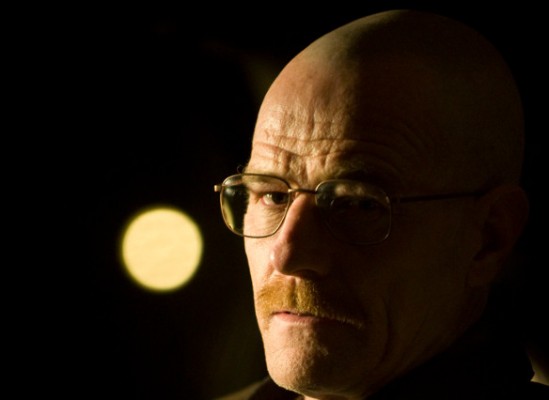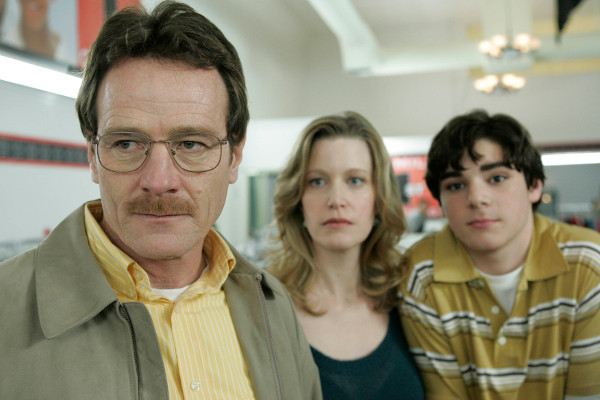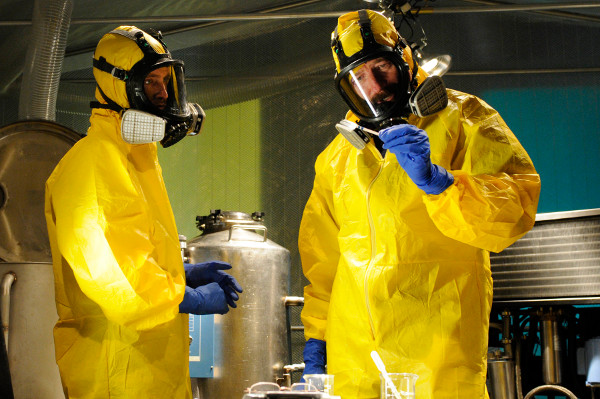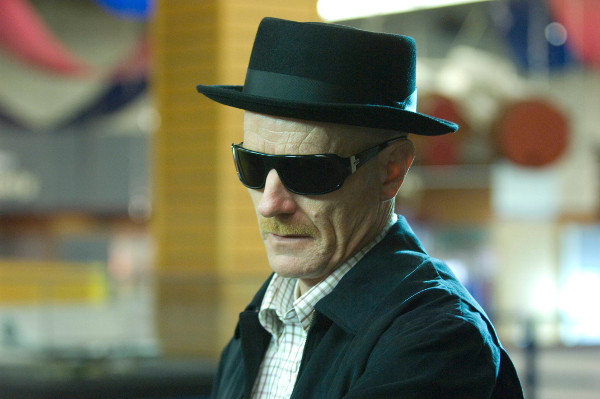Breaking Bad's Big Break
An excerpt from the new book Difficult Men: Behind the Scenes of a Creative Revolution: From The Sopranos and The Wire to Mad Men and Breaking Bad (Penguin Press, 2013) by Brett Martin. On July 26, the exhibit From Mr. Chips to Scarface: Walter White's Transformation in Breaking Bad will open at Museum of the Moving Image, on view through October 27, 2013.
In 2005, [Vince] Gilligan was on the phone with
an old friend and fellow X-Files writer Thomas Schnauz. The two were
complaining about the state of the movie business and wondering what they might
be qualified to do instead.
“Maybe we can be greeters at Walmart,”
Gilligan said.
“Maybe we can buy an RV and put a meth lab in the back,” said Schnauz.
“As he said that, an image popped into my head of a character doing exactly
that: an Everyman character who decides to ‘break bad’ and become a criminal,”
Gilligan recalled. It was a powerful enough image that he got off the phone and
began jotting down notes. The heart of the show came together in a hurry. The
main character, Walter White, is a mild and beaten-down high school chemistry
teacher who finds himself diagnosed with lung cancer. Inadequately insured,
with a baby on the way, he is desperate to provide for his family when he’s
gone and hits on the idea of going into the crystal meth business with a junkie
ex-student named Jesse Pinkman, played by Aaron Paul. Thanks to White’s
chemistry expertise and relative (by the standard of meth dealers) discipline
and devotion to quality, Walt and Jesse’s product becomes much in demand.
Legal, familial, and moral complications ensue.

Bryan Cranston as Walter White
The underlying project Gilligan had in mind, though, was something deeper—a
radical extension of the antihero trend that had by then become the signature
of the decade’s TV. The idea was to convincingly transform a milquetoast into a
monster or, as Gilligan often put it, “Mr. Chips into Scarface.” As the series
progressed, he would take away Walt’s justifications for his criminal behavior
one by one—starting with the cancer, which quickly went into remission. At the
same time, Gilligan, more than any other showrunner except maybe David Simon in
The Wire, gave Walt adversaries the viewer actually cared for—foremost
his own brother-in-law, Hank, a DEA agent with whom Walt ends up locked in a
zero-sum game. This was not The Shield; it was not at all clear whom to
root for. The series became a study in empowered masculinity run horribly amok,
without even the compensatory wish fulfillment granted Tony Soprano or Don
Draper. This made the challenge even more direct: Why did we still want
Walt to win? Effectively, it was a five-season-long “College” episode.
Walt’s journey to darkness was not the only way in which Breaking Bad
would come to seem like both an echo of and an answer to The Sopranos,
The Wire, and other shows that had ushered in the Third Golden Age.
Walter’s wife, Skyler, played by Anna Gunn, would end up as a distant
sister-wife to Carmela Soprano, grappling with her husband’s crimes and their
implications, especially for her children, to a degree that her predecessor
never did. More important, whereas the antiheroes of those earlier series were
at least arguably the victims of their circumstances—family, society,
addiction, and so on— Walter White was insistently, unambiguously, an agent
with free will. His journey became a grotesque magnification of the American
ethos of self-actualization, Oprah Winfrey’s exhortation that all must find and
“live your best life.” What if, Breaking Bad asked, one’s best life
happened to be as a ruthless drug lord?
One of the first things you do, when you have an idea like this, is ask
yourself, "Is it a TV show or a movie?,” Gilligan said. Twenty years
earlier, there would have been no question that it was a movie. In 2005,
though, he quickly decided that cable TV was his only hope.
Which didn’t mean that, about halfway through his pitch to executives at Sony
Television, he didn’t hear himself talking and think, “Gee, this is crazy.”
Against the odds, Sony bought the idea and arranged a pitch meeting at TNT. It
was, Gilligan remembered, the best meeting of his life. The TNT execs were at
the edge of their seats, asking what happened next, laughing at all the right
places. When Gilligan was done, they looked at one another, crestfallen. “We
don’t want to be stereotypical philistine executives,” one finally said, “but
does it have to be meth? We love this, but if we buy it, we’ll be fired.”

Bryan Cranston as Walter White, Anna Gunn as Skyler White, and RJ Mitte as Walter White, Jr.
Still, Gilligan remembered the meeting
fondly. “I give them great credit for not leaving me hanging,” he said. “The
best meeting of all is when they buy your story in the room. A close second is
when they turn you down quickly. And the third way is you do your song and
dance and go away and never hear from anybody again.”
That was the meeting he had with Carolyn Strauss at HBO. “I couldn’t tell
whether she was loving it or hating it or even listening. We got to the end,
and she stood up and said, ‘Well, thanks for coming in.’ I said to my agent,
‘Oh boy. I guess this isn’t going to be an HBO show.’” Indeed, HBO never gave
them an answer of any kind.
At the next meeting, with FX, another potential obstacle presented itself. John
Landgraf listened to the pitch and said, “Sounds a little like Weeds,”
the recently debuted Showtime series about a suburban mom who becomes a pot
dealer. Gilligan, who didn't have Showtime, felt his stomach fall into his crotch.
“What is Weeds?” he asked.
In the end, Landgraf judged Breaking Bad
different enough to order a pilot. But by the time, two months later, that Gilligan
handed it in, there was yet another problem. The network was committed to
making only one new series that year, and it had come down to Breaking Bad and Dirt, starring Courteney Cox, fresh off the juggernaut run of Friends, as the editor of a tabloid gossip
magazine.
“Nobody had a crystal ball, but at the time it made perfect sense to go with Dirt,” Gilligan said, though the show
would be canceled after two seasons. “I think they were trying to expand their
female viewership, and Dirt came with
a bona fide television star. I don’t blame them a bit.” Breaking Bad, however, he assumed was “dead as a
doornail.”
So gracious was Gilligan about these and most other matters that one had to
remind oneself he was the author of some of the most harrowing, grisly, gleefully
sanguine scenes ever to appear on television of any kind: a human body
dissolved by acid in a bathtub, for instance, the acid subsequently burning through
both tub and floor, so that the entire pink, swollen mess came crashing down in
a magnificent sploosh. In case that
somehow slipped your mind, the writers’ room was peppered with further reminders—most
strikingly, a clay model of a tortoise on whose back rested a decapitated,
mustachioed head. It was a reproduction of an indelible
image from season two.

Aaron Paul as Jesse Pinkman and Bryan Cranston as Walter White
Yet even in the midst of great violence, a certain gentlemanliness reigned. In
the script for one of the tensest episodes of the series, in which Jesse and Walt
are being held captive in a desert hideout by a psychotic dealer named Tuco, a
stage direction contained a parenthetical that would be hard to imagine in a Sopranos or Mad Men
script: “Tuco lunges at Jesse, grabs him by the collar (or hair, if we can make
that work without hurting Aaron).”
Gilligan had been justified in assuming, when FX passed on producing Breaking Bad’s pilot, that none of this
would ever see the light of day. FX owned the show outright, and networks were
generally disinclined to see shows they had developed become hits on other
channels. That was what had happened to a pilot Gilligan had shot for CBS. “They
said, ‘We’re not going to let you make it. We bought it and now we’re going to
keep it in a file cabinet somewhere,’” Gilligan said. “At a corporate
level I understand those kinds of decisions,
but they’re hard to justify in any moral way.”
In any event, the question was moot. HBO, Showtime, TNT, and now FX had passed
on Breaking Bad. “There was no place
left in the known universe,” Gilligan said. With a TV veteran’s stoicism, he
stopped thinking about the show and turned to yet another rewrite of Hancock.
By that time, however, Jeremy Elice, who while working at FX had watched the
show’s development process excitedly and then disappointedly, had landed at AMC.
He certainly remembered it when ICM agent Mark Gordon called to say it might
still be available. He and Christina Wayne set up a meeting with Gilligan at
the L’Ermitage Beverly Hills hotel. Gilligan was dubious but agreed.
“I figured I’ll go to the meeting, get flattered for a half hour, drink a $14
Scotch, and that’s all fine with me. Just another jerk-off meeting.”
Wayne and Elice laid out what was going on at AMC, where the pilot for Mad Men had just been shot. Gilligan, in
turn, impressed them by sketching out a multi-season, detailed arc for the show.
“Christina and I were getting more and more excited,” said Elice. “We’re like,
‘He’s really going to have cancer! Not like Beverly
Hills, 90210 cancer. Real cancer!’”
As for Gilligan, “I liked what I heard. I never thought they were bullshitting.
But I have to confess that I also left thinking, ‘Man, this is never going to
happen.’”
Back in New York, the script stalled on Rob Sorcher’s desk. “I didn’t want to
read it,” he admitted cheerfully. “I didn’t want to read the fucking script about
the meth dealer with cancer.” For two weeks, Elice and Wayne urged him to pick
it up. “This is fucking great,” he said, once he finally did. “Why didn’t you
tell me?”

Bryan Cranston as Walter White
It still remained to cut a deal with FX and with Sony. Nine months of
negotiations passed, during which Elice and Gordon, the agent, spoke nearly every
day. In the end, only one hurdle remained: a $5,000-per-episode royalty on “new
media”—a term that was beginning to mean more and more—that Sony was demanding. Sorcher used the
company helicopter to fly out to Cablevision’s Long Island headquarters and
made the request personally. Finally, the deal was done and Breaking Bad became the property of AMC.
To Sorcher, this was the defining decision of his time at AMC—even more consequential,
and requiring more nerve, than green-lighting and taking on the expense of the Mad Men pilot. At least that show and Broken Trail were of a piece with some
existing elements of the network’s brand; they could be packaged with The Apartment or El Dorado or other films from AMC’s well established inventory.
Breaking Bad fit no discernible genre at all—except quality. “‘If we do this,’
I thought, ‘we’re going all the way out on this limb,’” Sorcher said. “We had
had success with Mad Men. And once
you’ve had that cookie, it tastes good. You want another one. The decision to
go a different way, believe me, it was fucking terrifying. But once you did,
once you chose quality over everything else... you could do anything.”
![]()
LATEST ARTICLES
-20140814-173707-thumb3.jpg)
Fighting Words
by Imogen Sara Smith
posted August 12, 2014

Fighting Words, Part 2
by Imogen Sara Smith
posted August 20, 2014

On the Margins: The Fil…
by Andrew Chan
posted August 12, 2014

Robin Williams: A Sense…
by David Schwartz
posted August 12, 2014
 Breaking Bad's Big Break
Breaking Bad's Big Break

